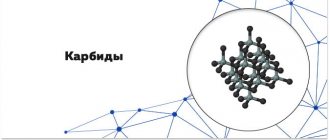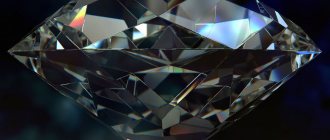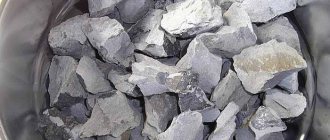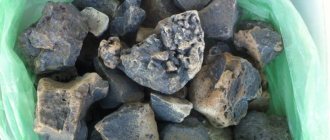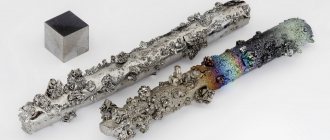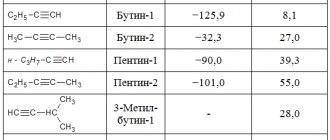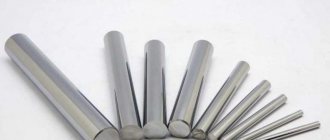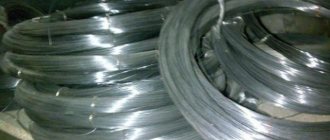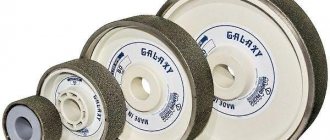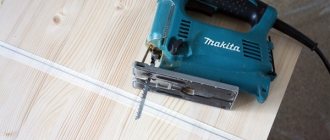Compound
There are currently hundreds of WC-based tungsten carbides with varying compositions, most of which use cobalt (Co) as the binder. Nickel (Ni) and chromium (Cr) are also commonly used as binder elements, but other alloying elements may be added.
Why are there so many grades of carbides? How do tool manufacturers select the appropriate tool material for a particular cutting process? To answer these questions, let's first understand the various properties that make tungsten carbide an ideal tool material.
Connection properties
Tungsten carbide based alloys have the following advantages:
- oxidation resistance;
- plasticity exhibited under load;
- does not react with many acids;
- chemically inactive, therefore it is classified as a low-toxic substance;
- polished alloy cannot be scratched;
- does not fade over time;
- infusibility;
- increased hardness, which does not decrease at high temperatures.
Tungsten metal compound alloys have many advantages
The last two properties are due to the strong bonds between the atoms in the crystals that make up the compound.
What is tungsten carbide? - unity of hardness and strength
Tungsten carbide WC-Co has a unique advantage in both hardness and toughness. Tungsten carbide (WC) itself has a very high hardness, and its hardness rarely decreases as operating temperature increases. However, it does not have sufficient strength, which is an essential property for cutting tools. To take advantage of the high hardness of tungsten carbide and increase its strength, metal binders are used to bond tungsten carbide so that the material has a hardness significantly greater than that of high-speed steel and is able to withstand most cutting processes. In addition, it can withstand the high processing temperatures obtained through high-speed processing.
The high modulus of elasticity of the WC-Co material (about three times higher than high-speed steel) provides a non-reversible coating substrate. WC-Co also provides the required toughness. These properties are the basic properties of WC-Co materials, but they can also be tailored to the material composition and microstructure when producing tungsten carbide powders. Therefore, the suitability of a tool's performance for a particular process depends largely on the initial grinding process.
Zirconium carbide ZrC
Zirconium carbide is a gray compound with a metallic luster. It is chemically inert at room temperature: it dissolves poorly in concentrated acids, their mixtures and some alkalis, both in cold and heated states. Zirconium carbide is insoluble in water, but reacts with nitrogen to form nitrides.
The temperature of active oxidation of ZrC is 1100...1200°C, the temperature stability range is up to 3530°C.
Zirconium carbide is resistant in melts of copper and copper alloys, steel, cast iron and low-melting metals. Physical properties of zirconium carbide ZrC
| Molecular mass | 103,2 |
| Grille type | Cubic |
| Density, kg/m3 | 6730 |
| Melting point, °C | 3530 |
| Boiling point, °C | 5100 |
| Mohs hardness | 8-9 |
| Average TCLE in the range 20-1100°С, α·106, deg-1 | 6,74 |
| Molar heat capacity at 20°C, kJ/(kmol deg) | 61,1 |
| Specific mass heat capacity at 25°C, J/(kg deg) | 456 |
| Thermal conductivity coefficient at 0°C, W/(m deg) | 42 |
| Electrical resistivity at 20°C, ρ·108, Ohm·m | 50 |
What is the grinding process for tungsten carbide?
Tungsten carbide powder is produced by carburizing tungsten (W) powder. The properties of tungsten carbide powder, especially its particle size, are primarily dependent on the particle size of the raw tungsten powder and the carburization temperature and time. Chemical control is also important and the carbon content must be kept constant (close to the theoretical ratio of 6.13% by weight). To control particle size through the downstream process, a small amount of vanadium and/or chromium must be added before carburization is carried out.
Different processes and different endpoints require a combination of specific tungsten carbide particle size, carbon content, vanadium content and chromium content, and variations in these combinations can result in different tungsten carbide powders.
When tungsten carbide powder is mixed and ground with a metal bond to produce a specific grade of tungsten carbide powder, it is at this time that various combinations can be obtained. The most commonly used cobalt content is from 3 to 25 wt.%, and nickel and chromium are added to improve the corrosion resistance of the tool. Additionally, the metallic bond can be further improved by adding other components to the alloy. For example, adding niobium to tungsten carbide WC-Co can significantly improve strength without reducing its hardness. Increasing the amount of binder can also increase the toughness of tungsten carbide, but this will reduce its hardness.
Reducing the tungsten carbide particle size can increase the hardness of the material, but during the sintering process, the tungsten carbide particle size must remain unchanged. During sintering, the tungsten carbide particles are combined and grown through a process of dissolution and redeposition. During the actual sintering process to form a fully dense material, the metal bond turns into a liquid state (called liquid phase sintering).
The growth rate of tungsten carbide particles can be controlled by adding other transition metal carbides, including vanadium carbide (VC), chromium carbide (Cr3C2), titanium carbide (TiC), tantalum carbide (TaC), and niobium carbide (NbC). These metal carbides are usually added during mixing and grinding of tungsten carbide powder along with a metal binder, although vanadium carbide and chromium carbide can also be formed during carburization of tungsten carbide powder.
Grades of tungsten carbide powder can also be produced from recycled solid carbide materials. Recycling and reusing used tungsten carbide has a long history in the tungsten carbide industry and is an important part of the industry's entire economic chain, helping to reduce material costs, conserve natural resources and avoid waste. Harmful removal. Waste tungsten carbide can usually be reused by the APT (ammonium paratungstate) process, zinc recovery process or atomization. These "recycled" tungsten carbide powders typically have better predictable compaction because their surface area is less than tungsten carbide powder obtained directly from the tungsten carburization process.
Processing conditions for mixing tungsten carbide powder with a metal bond are also critical process parameters. The two most common milling methods are ball milling and ultra-fine milling.
Both processes mix the ground powder evenly and reduce particle size. To provide a workpiece clamp with sufficient strength to maintain the workpiece's shape and allow an operator or robot to pick up the workpiece for work, it is usually necessary to add an organic binder during the milling process. The chemical composition of such a binder can affect the density and strength of the pressed part. To facilitate the operation, it is preferable to add a high strength binder, but this results in a lower compressive density and can cause hard blocking, resulting in defects in the final product.
Once grinding is complete, the powder is typically spray dried to form a free flowing mass which is agglomerated with an organic binder. By adjusting the composition of the organic binder, the fluidity and charge density of these agglomerates can be tailored to suit needs. When screening larger or smaller particles, the particle size distribution of the agglomerates can be further tailored to ensure good flow when loaded into the mold cavity.
Receipt
Tungsten carbide can be obtained by one of the following methods.
Direct saturation of tungsten with carbon
The process of producing tungsten carbide is based on a direct reaction:
In the presence of carbon monoxide in the medium, the process proceeds according to the reaction
Typically, the process of producing tungsten carbide is carried out at a temperature of 1300−1350 °C for fine-grained tungsten powders and 1600 °C for coarse-grained ones, and the holding time is from 1 to 2 hours. The resulting slightly sintered tungsten carbide blocks are crushed and sifted through sieves.
Reduction of tungsten oxide with carbon followed by carbidization This method, in contrast to the above, combines the process of reduction and carbidization of tungsten, while the missing amount of soot is added to the charge to form carbide. The reduction of tungsten oxide WO3 occurs through the gas phase in an environment of CO and hydrogen. Reduction of tungsten compounds followed by carbidization Another method for producing tungsten carbide is heating a mixture of tungstic acid, tungstic anhydride (WO3) or ammonium paratungstate ((NH4)10 [H2W12O42] xH2O) in an environment of hydrogen and methane at a temperature of 850−1000 °C . By deposition from the gas phase The production of tungsten carbide from the gas phase is based on the decomposition of tungsten carbonyl at a temperature of 1000 °C. Electrolysis of Molten Salts Electrolysis of a mixture of molten sodium borate, sodium carbonate, lithium fluoride and tungsten anhydride produces tungsten carbide. Tungsten carbide single crystals WC single crystals can be obtained by melt growth. To do this, a mixture with the composition Co−40%WC is melted in an aluminum oxide crucible at a temperature of 1600 °C and, after homogenization of the melt, the temperature is reduced to 1500 °C at a rate of 1−3 °C/min and maintained at this temperature for 12 hours. After which the sample is cooled and the cobalt matrix is dissolved in boiling hydrochloric acid. The Czochralski method can also be used to grow large single crystals (up to 1 cm).
What is the manufacturing method of tungsten carbide blanks?
Carbide blanks can be formed by various processes. Depending on the size of the workpiece, the level of complexity of the shape and the size of the production batch, most cutting inserts are formed using a rigid top and bottom pressure mold. To maintain consistency in the weight and size of the workpiece in each press, it is necessary to ensure that the amount of powder (mass and volume) flowing into the cavity is exactly the same. The liquidity of the powder is mainly controlled by the size distribution and characteristics of the organic binder. A molded preform (or "preform") can be formed by applying a molding pressure of 10-80 ksi to the powder loaded into the cavity.
Even at extremely high molding pressures, the solid tungsten carbide particles are not deformed or fractured, and the organic binder is pressed into the gap between the tungsten carbide particles, thereby functioning to fix the position of the particles. The higher the pressure, the tighter the bonding of the tungsten carbide particles and the greater the compaction density of the workpiece. The forming properties of granular tungsten carbide powder can vary depending on the amount of metal binder, the size and shape of the tungsten carbide particles, the degree of agglomeration, and the composition and amount of the organic binder. To provide quantitative information about the molding characteristics of tungsten carbide powder, the powder manufacturer usually establishes a correspondence between molding density and molding pressure. This information ensures that the powder supplied is compatible with the tooling molding process.
Large format carbide blanks or high aspect ratio carbide blanks (such as end mills and shanks) are typically made by uniformly pressing tungsten carbide powder in a flexible bag. Although the production cycle of the equalization pressing method is longer than the molding method, the tool manufacturing cost is lower, so this method is more suitable for small batch production.
This process involves loading the powder into a bag and sealing the mouth of the bag, then placing the bag filled with powder in a chamber and applying 30-60 kpsi pressure. inch using hydraulic pressing device. Pressed products are typically machined to a specific geometry before sintering. The size of the bag is increased to allow for shrinkage of the workpiece during the compaction process and to provide sufficient allowance for the grinding process. Since the workpiece is processed after pressing, the charge consistency requirements are not as strict as the molding method, but it is still desirable to ensure that the amount of powder per load is the same.
Carbide blanks can also be formed by extrusion or injection molding. The extrusion process is more suitable for the mass production of axisymmetric workpieces, while the injection molding process is generally used for the mass production of complex shaped workpieces. In both molding processes, a grade of tungsten carbide powder is suspended in an organic binder, which imparts uniformity to the tungsten carbide mixture, such as toothpaste. The mixture is then extruded through an orifice or molded into a mold cavity. The characteristics of the tungsten carbide powder determine the optimal powder to binder ratio in the mixture and have an important influence on the flow of the mixture through the extrusion orifice or into the mold cavity.
After the preform is formed by molding, extrusion, extrusion or injection molding, the organic binder must be removed from the preform before the final sintering step. Sintering removes the pores in the workpiece, making it completely (or substantially) dense. During sintering, the metal bond in the pressed part becomes a liquid, but the workpiece can maintain its shape by capillary force and particle contact.
After sintering, the geometry of the part remains unchanged, but the size decreases. To obtain the required workpiece size after sintering, the shrinkage rate must be taken into account when designing the tool. When designing the grade of tungsten carbide powder used to make each tool, it is necessary to ensure that it shrinks correctly when pressed under the appropriate pressure.
In almost all cases, the sintered billet, also called carbide billet, must be sintered. The most basic processing of cutting tools is sharpening the cutting edge. Many tools require grinding and refinishing their geometry after sintering. Some tools require chopping at the top and bottom; others require peripheral grinding (with or without sharpening the cutting edge). All wear residues from carbide grinding can be recycled.
Calcium carbide CaC2
The table shows the physical properties of calcium carbide CaC2. According to its optical properties, chemically pure calcium carbide is large, almost colorless crystals with a bluish tint. Technical CaC2, depending on the degree of purity, has a gray, brownish-yellow or black color.
The temperature resistance limit for calcium carbide is 2300°C.
At a temperature of 20°C, it completely dissolves in water (with the release of acetylene) and concentrated hydrochloric acid. Physical properties of calcium carbide CaC2
| Molecular mass | 64,1 |
| Grille type | Tetragonal, cubic |
| Density, kg/m3 | 2100 |
| Melting point, °C | 2300 (decomp.) |
| Specific mass heat capacity at 25°C, J/(kg deg) | 960 |
| Molar heat capacity at 25°C, kJ/(kmol deg) | 61,3 |
How to prepare the coating of tungsten carbide workpiece?
In many cases the finished part must be coated. The coating provides lubricity and increased hardness and provides a diffusion barrier to the substrate that prevents oxidation when exposed to high temperatures. The tungsten carbide matrix is critical to the coating's performance. In addition to the basic characteristics of the tunable matrix powder, the surface properties of the substrate can be tailored by chemical selection and modification of the sintering process. Due to the movement of cobalt, more cobalt can be enriched in the outermost layer of the blade surface with a thickness of 20-30 microns relative to the rest of the workpiece, thereby imparting better toughness to the surface layer of the substrate, which has strong resistance to deformation.
Tool manufacturers, based on their own manufacturing processes (such as dewaxing methods, heating rates, sintering times, temperatures and carburizing stresses), may have special requirements for the grades of carbide powder used. Some toolmakers may sinter blanks in vacuum furnaces, while others may use hot isostatic pressing (HIP) sintering furnaces (which seal the blank at the end of the process cycle to eliminate residues). Pore). A preform sintered in a vacuum furnace can also be subjected to a hot isostatic pressing process to increase the density of the preform. Some toolmakers may use higher vacuum sintering temperatures to increase the sintered density of lower cobalt mixtures, but this approach may produce a coarser microstructure.
To maintain a fine grain size, smaller particle size tungsten carbide powder can be used. To match specific production equipment, dewaxing conditions and carburizing stress also have different requirements for the carbon content of tungsten carbide powder. All these factors have a decisive influence on the microstructure and material properties of the tungsten carbide tool that is sintered. Therefore, there is a need for close communication between the tool manufacturer and the powder supplier to ensure that it is manufactured according to the tool. Customized production process custom made tungsten carbide powder. It is therefore not surprising that there are hundreds of different grades of carbides. For example, ATI Alldyne produces over 600 different brands of powders, each specifically designed for the intended user and specific use.
Properties
The substance in question is represented by a gray powder in two crystallographic variants: with cubic (semicarbide) and hexagonal (monocarbide) lattices. Both modifications are found in the temperature range 2525 - 2755°C. The second phase, due to the absence of a homogeneity region, when deviating from the stoichiometric composition, forms graphite or transforms into W2C, and at temperatures above 2755°C decomposes to carbon and the first phase. The latter is distinguished by a large region of homogeneity, which shrinks with decreasing temperature.
Tungsten monocarbide is less hard than semi-carbide, but is capable of forming crystals. The second option is much more temperature and wear resistant. In addition, it is capable of incorporation into solid solutions.
Tungsten carbide is brittle, but under the influence of load it exhibits ductility with slip bands.
Crystals of the substance under consideration are characterized by hardness anisotropy from 13 to 22 GPa on different crystallographic planes.
Monocarbide has a melting point of 2870°C and a boiling point of 6000°C. Its molar heat capacity is 35.74 J/(mol-*K), thermal conductivity is 29.33 kJ/mol. The density of this type of tungsten carbide is 15.77 g/cm3.
Despite the fact that the melting point is high, the heat resistance of the material in question is low. This is due to the lack of thermal expansion due to the rigid structure. At the same time, tungsten carbide is characterized by high thermal conductivity. With increasing temperature, this parameter for monocarbide increases twice as fast as for semi-carbide.
Tungsten Carbide Ring
The materials in question have good electrical conductivity, especially semi-carbide (4 times higher than monocarbide). Electrical resistivity increases with increasing temperature, but elasticity decreases. This determines machinability using electrophysical methods. Thus, when a heat source is introduced into the processing area, the temperature increases, contributing to the gradual destruction of the material structure.
Hardness is determined by the temperature at which carbides form in the tungsten powder and (to a lesser extent) by their porosity. With increasing temperature, the mobility of the atoms of the elements that make up the compound increases, as a result of which defects in the grains are eliminated. The anisotropy of parameters of tungsten carbides is less than for metals. In addition, these materials are characterized by the best elasticity for refractory metals, which increases with increasing porosity. However, ductility is low (up to 0.015%).
Microstructure of tungsten carbide
Tungsten carbide is resistant to many acids and their mixtures at ordinary temperatures, but is soluble in some acids at boiling temperatures. Not susceptible to dissolution in 20% and 10% sodium hydroxide. Due to the high volatility of tungsten oxide, it begins to oxidize at 500 - 700°C and completes oxidation at more than 800°C.
Finally, due to its chemical inertness, this compound is non-toxic.
What is the classification method for tungsten carbide grades?
A combination of different types of tungsten carbide powder, mixture composition and binder metal content, type and amount of grain growth inhibitors, etc. Represents many grades of carbide. These parameters will determine the microstructure and properties of tungsten carbide. Some specific performance combinations have become the first choice for specific machining applications, allowing several grades of carbides to be classified.
The two most commonly used carbide machining classification systems for machining purposes are the C-Class system and the ISO quality system. While none of these systems fully capture the material properties that influence the selection of carbide grades, they provide a starting point for discussion. For each taxonomy, many manufacturers have their own specialty grades, resulting in a wide variety of carbide grades.
Carbide grades can also be classified by composition. Tungsten carbide (WC) can be divided into three main types: plain, microcrystalline and alloy. Simple grades consist primarily of tungsten carbide and cobalt binders, but may also contain small amounts of grain growth inhibitors. The microcrystalline grade consists of tungsten carbide and a cobalt binder with several thousand vanadium carbide (VC) and/or chromium carbide (Cr3C2), and its grain size can be less than 1 micron. The alloy grade consists of tungsten carbide and a cobalt binder containing several percent titanium carbide (TiC), tantalum carbide (TaC) and niobium carbide (NbC). These additives are also called cubic carbides due to their sintering properties. The resulting microstructure has a heterogeneous three-phase structure.
Hafnium Carbide GfC
The table shows the properties of hafnium metal carbide. Hafnium carbide is a gray compound with a melting point of 3890°C and a high density, which at room temperature is 12600 kg/m3. The energy of the GfC crystal lattice is 117.2·105 kJ/kmol.
Hafnium carbide is completely soluble in orthophosphoric, nitric and sulfuric acids.
At a temperature of about 2000°C, it begins to interact with refractory metals such as molybdenum, tungsten, tantalum and niobium. Physical properties of hafnium carbide GfC
| Molecular mass | 190,5 |
| Grille type | Cubic |
| Density, kg/m3 | 12600 |
| Melting point, °C | 3890±150 |
| Boiling point, °C | 4160 |
| Average TCLE in the range 20-1200°С, α·106, deg-1 | 6,1 |
| Molar heat capacity at 20°C, kJ/(kmol deg) | 35,3 |
The thermal conductivity of hafnium carbide with zero porosity at a temperature of 300°C is 9.2 W/(m deg).
When heated, the thermal conductivity coefficient GfC increases. The specific heat capacity of hafnium carbide is relatively low and increases slightly with increasing temperature. Specific heat capacity and thermal conductivity of hafnium carbide at temperatures from 300 to 1200°C
| 300 | 400 | 600 | 800 | 1000 | 1200 | |
| Specific mass heat capacity, J/(kg deg) | 251 | 251 | 255 | 268 | 281 | 297 |
| Thermal conductivity coefficient, W/(m deg) | 9,2 | 10 | 11,7 | 13,8 | 15,9 | 17,2 |
(1) SIMPLE CARBIDE GRADE
These metal cutting grades typically contain 3%-12% cobalt (by weight). Tungsten carbide grain sizes are typically in the range of 1-8 microns. As with other grades, reducing the particle size of tungsten carbide increases its hardness and transverse tensile strength (TRS) but reduces its toughness. The hardness of simple grades is usually between HRA 89-93.5; transverse tensile strength is typically 175-350 ksi. Such powders may contain large amounts of secondary raw materials.
Simple grades can be divided into C1-C4 in the C class system and can be classified according to the K, N, S and H class standards in the ISO quality system. Simple grades with intermediate characteristics can be classified as general grades (e.g. C2 or K20) for turning, milling, planing and boring; grades with smaller grain sizes or lower cobalt content and higher hardness may be classified as a finish grade (e.g. C4 or K01); grades with larger grain sizes or higher cobalt content and better toughness may be classified as coarse (eg C1 or K30).
Plain grade tools can be used to cut cast iron, 200 and 300 series stainless steel, aluminum and other non-ferrous metals, superalloys and hardened steel. These grades can also be used in non-metallic environments (such as drilling and geological drilling tools) with grain sizes ranging from 1.5 to 10 microns (or larger) and cobalt levels from 6% to 16%. Another non-metallic cutting type of simple carbide grades is the production of molds and punches. These varieties typically have a medium grain size with a cobalt content of 16-30%.
Tips for buying jewelry.
The first thing you should do when purchasing tungsten jewelry is to make sure you know what is included in the piece you are being offered.
As you have already seen, these two materials differ in strength and chemical composition. If you're looking for durability, make sure the jewelry you buy is made from tungsten carbide.
You should also ask about all the other metals that a particular tungsten product contains.
There are some pieces of jewelry that are cheaper, and often the reason is that they contain cobalt instead of nickel (we've already talked about why cobalt is not preferred).
Even if jewelry is labeled as "tungsten carbide," you should still check because some items may be made with cobalt: an unusually low price is one sign that this is the case.
(2) MICRO CRYSTALLINE CARBIDE GRADE
Such grades typically contain 6%-15% cobalt. In liquid phase sintering, added vanadium carbide and/or chromium carbide can control grain growth, thereby producing a fine-grained structure with a particle size of less than 1 µm. This fine-grained grade has very high hardness and a transverse tensile strength of 500 ksi. The combination of high strength and sufficient toughness allows these classes of tools to have a higher positive bevel angle, which reduces cutting forces and produces thinner chips by cutting rather than pushing the metal.
By strictly identifying the quality of various raw materials in the production of tungsten carbide powder grades and strictly controlling the sintering process conditions, the formation of abnormal large grains in the microstructure of the material can be prevented. Material properties. To keep the grain size small and uniform, recycled powder can only be used if the raw materials and recovery process are fully controlled and extensive quality testing is carried out.
Microcrystalline grades can be classified according to the M series standards of the ISO quality system. In addition, other classification methods in the C class system and ISO grading system are the same as simple classes. Microcrystalline grades can be used to make tools for cutting softer workpiece materials because the tool surface can be machined very smoothly and maintain an extremely sharp cutting edge.
Microcrystalline grades can also be used for machining nickel-based superalloys as they can withstand cutting temperatures up to 1200°C. For machining high temperature alloys and other special materials, the use of micro-grain tools and simple enamel tools can simultaneously improve their wear resistance, deformation resistance and viscosity.
Application of Tungsten Refractoriness
This quality of metal is widely used for the production of:
- filaments in lighting devices;
- electrodes in argon-arc welding;
- heating elements for high-temperature vacuum resistance furnaces;
- cathode ray tubes in monitors, oscilloscopes, and radar stations;
- electronic tubes.
Vacuum tubes in most industries have been replaced by semiconductors, except for the production of high-voltage, high-power, high-frequency equipment, as well as space technology. Along with the advantages, refractory metal also has disadvantages:
- complexity of machining;
- at air temperatures exceeding 400°C, oxide films are formed, and in the presence of sulfur-containing substances in the environment, sulfide films;
- Large contact pressures are required to create even low resistance at the electrical contact site.
To neutralize the described disadvantages, the material is alloyed with other metals that improve its properties. There are several such connections:
- Stellite. In addition to tungsten, it contains cobalt and chromium. It is applied by spraying or fusing to spare parts of machines, tools, and machine tools to increase wear resistance. Stellite is used for the production of cutting tools.
- High-speed and tool steels from which drills, cutters, and dies are made. In addition to the main components, these compounds may contain chromium, manganese and silicon.
- Contact alloys. The alloying metals in them are copper and silver. The high electrical conductivity of these materials increases this indicator of the compounds in which they are included. Tungsten contact alloys are the material from which switches, knife switches, and electrodes are made.
- Hard alloys. They are based on tungsten carbide - a compound of a refractory metal with carbon. Thanks to these two components, the alloy is characterized by high hardness, melting point, and wear resistance. The listed characteristics are important for the working parts of tools used in drilling and cutting. The mass fraction of tungsten carbide in the hard alloy is 85–95%, the remaining percentages indicate the cobalt content.
(3) CARBIDE ALLOY TYPE
These grades are primarily used for cutting steel parts, which typically have a cobalt content of 5-10% and a grain size range of 0.8-2 microns. By adding 4% to 25% titanium carbide (TiC), the tendency of tungsten carbide (WC) to diffuse to the surface of scrap steel can be reduced. Tool strength, crater wear resistance and thermal shock resistance can be improved by adding no more than 25% tantalum carbide (TaC) and niobium carbide (NbC). The addition of such cubic carbides also increases tool reddening, which helps avoid thermal deformation of the tool during heavy duty cutting or other machining where the cutting edge may generate high temperatures. In addition, titanium carbide can provide nucleation sites during sintering, improving the uniformity of distribution of cubic carbide in the workpiece.
In general, carbide-type alloys have a hardness range of HRA91-94 and a transverse tensile strength of 150-300 ksi. Compared with the simple type, the wear resistance of the alloy has low wear resistance and low strength, but its wear resistance is better. Alloy grades can be classified into C5-C8 in the C class system and can be classified according to P and M class standards in the ISO quality system. Alloy grades with intermediate properties can be classified into general grades (e.g. C6 or P30) for turning, threading, planing and milling. The hardest grades can be classified as fine grades (eg C8 and P01) for finishing and boring. These grades typically have a smaller grain size and lower cobalt content to achieve the desired hardness and wear resistance. However, similar material properties can be achieved by adding more cubic carbides. The most resistant grades can be classified as coarse (eg C5 or P50). These grades typically have a medium particle size and high cobalt content, and the amount of cubic carbide added is also small to achieve the desired toughness by inhibiting crack propagation. In the interrupted turning process, cutting efficiency can be further improved by using a cobalt-rich grade having a higher cobalt content on the cutter surface.
Low titanium carbide content alloys are used for machining stainless steel and ductile iron, but can also be used for machining non-ferrous metals (such as nickel-based superalloys). These grades typically have a grain size of less than 1 micron and a cobalt content of 8% to 12%. Higher hardness grades (eg M10) can be used for machining ductile iron; grades with better toughness (eg M40) can be used for milling and planing steel or for machining stainless steel or superalloys.
Carbide alloys can also be used for non-metallic cutting, primarily to produce wear-resistant parts. These grades typically have a particle size of 1.2-2 microns and a cobalt content of 7%-10%. These grades typically add a higher proportion of recycled materials, resulting in increased cost-effectiveness when using worn parts. Worn parts require good corrosion resistance and high hardness. These grades can be obtained by adding nickel and chromium carbide during the production of such grades.
Application
Due to the above properties, there are several applications for tungsten carbide.
- It is used to produce parts with high corrosion resistance, wear resistance and hardness: milling cutters, abrasive materials, cutters, drills, chisels, etc.
- The connection in question is used for surfacing and thermal spraying in order to increase wear resistance by creating a hard surface.
- Tungsten carbide is used as a material for watch bracelets, bullet and projectile cores, jewelry, etc.
Applications of Tungsten Carbide
The optimal temperature range for items made from it is considered to be 200 - 300°C. The elasticity of this material ensures its use under alternating loads.
Conclusion
To meet the technical and economic needs of tool manufacturers, tungsten carbide powder is a key element. Powders designed for process equipment and process parameters of toolmakers ensure the performance of the finished part and result in hundreds of grades of carbide. The recyclable nature of carbide materials and the ability to work directly with powder suppliers allows tool manufacturers to effectively control the quality of their products and material costs.
Tungsten carbide versus tungsten.
People often use the terms tungsten and tungsten carbide interchangeably. However, there are differences in the properties of these two materials.
Firstly, tungsten scratches more easily.
Rings made from it alone are not very scratch resistant, so you shouldn't expect them to remain as shiny over time.
Secondly, tungsten jewelry often contains cobalt, while tungsten carbide is usually mixed with nickel. The problem is that when cobalt comes into contact with the skin, the metal can cause irritation.
Additionally, cobalt can oxidize and cause your jewelry to change color.
Commercial exploitation
HVOF tungsten carbide coatings are already being applied to various aircraft components and landing gear. For example, Engelhard uses HVOF coatings on both civil and military aircraft, including landing gear and power drives.
The United States Department of Defense, Air Force and Navy, as well as the growing private aircraft and jet engine manufacturing sectors, recognize the superiority of HVOF tungsten carbide coatings over electroplated chromium plating in terms of protection against wear, fatigue and corrosion.
Table 1. Characteristics of coatings.
| Property | HVOF tungsten carbide coating | Electroplated chrome |
| Microhardness, HRC | >70 | 60-70 |
| Microhardness, DPH 300 | >1050 | 750-850 |
| Adhesion strength, MPa | >80 | 41 |
| Porosity | <1% | — |
| Coating thickness, mm | >0,08 | <0,13 |
| Roughness, Ra | <4 | <4 |
| Corrosion Resistance Test (ASM B117), hours | 720 | 55 |
| Heat resistance, °C | 550 | 400 |
Peter F. Ruggerio, Engelhard Corp.
Iselin, New Jersey Advanced Materials and processes, July 2005 Translation: Denis Krasnov LLC “Technological Systems of Protective Coatings”
Tungsten and rhenium
The alloy of these two elements is quite widely used for the manufacture of high-temperature thermocouples. Tungsten - what metal? Like rhenium, it is a heat-resistant metal, and alloying the elements reduces this property. But what if you take two almost identical substances? Then their melting point will not decrease.
If rhenium is used as an additive, an increase in the heat resistance and ductility of tungsten will be observed. This alloy is produced by smelting in powder metallurgy. Thermocouples made from these materials are heat-resistant and can measure temperatures above 2000°C, but only in an inert environment. Of course, such products are expensive, because in one year only 40 tons of rhenium and only 51 tons of tungsten are mined.
We hope that the Bundesbank and of course the German people will use some of this in the near future (up to and including 2021).
Ultrasonic testing of gold bars
Application: Non-destructive testing of the physical integrity of gold bars.
Explanations:
Gold bars were fraudulently counterfeited by inserting bars of non-precious metal of similar density. Such inserts are difficult or impossible to detect by weighing, radiography, or X-ray fluorescence, so some metal technologists resort to drilling holes or cutting ingots to test for integrity. However, a simple ultrasonic test can quickly and reliably locate the inserts without having to drill, cut or otherwise modify the ingot.
Equipment:
Any Olympus flaw detector or phased array instrument such as: EPOCH XT, EPOCH 600, EPOCH 1000, OmniScan SX and OmniScan MX2. It is recommended to use a converter frequency of 2.25 MHz.
Principle:
A fake gold bar with another metal inside changes the path that ultrasonic waves take through the metal in a predictable way. Insertion of material other than gold, as well as voids within the ingot, will change the angles at which the waves are reflected. Large inserts that occupy most of the ingot can also be detected by changes in the speed of sound.
1. Pulse/echo reflection method
Ultrasonic waves passing through any medium will travel in one direction until they reach an interface with another material, causing them to be reflected in the direction of the source.
Ultrasonic flaw detectors and phased array instruments generate pulses of high-frequency sound waves from small hand-held transducers. Sound energy interacts with the test object, the device measures and displays a picture of the distribution of reflected signals. Signals reflected from the inside of the gold bar, rather than from its opposite surface, change the pattern and indicate the presence of either an insert of another metal or an internal cavity.
Read also: Tensile strength of metals table
In this test, the sensor's reference signal, i.e., the signal reflected by the bottom surface of a known gold bar, is first recorded. Strobe pulses can be used to measure the time it takes for the ultrasonic wave to reach the bottom surface. All reflected signals from the area marked by the strobe pulse indicate that the sound stream is reflected from the boundary of the heterogeneity of the material, and further inspection of the ingot is necessary. Below are typical pictures on the screen.
Images on the flaw detector screen in cases of monolithic metal (above) and damaged metal (below).
Note. The signal appears in the interval marked in red.
Images of solid metal (above) and metal with heterogeneity (below), obtained using a phased array device. The heterogeneity appears in color where there should be a white background.
2. Speed measurement method
The speed of sound in pure gold is 3.240 m/s or 0.1275 in/µs. In harder gold alloys used in jewelry, the speed is higher, but each alloy also has a specific speed value. If the speed of sound propagation is different from the expected value, this means that the composition of the metal has been changed.
Greetings to all masters!
In general, this is the situation I have, my relatives decided to sell my grandfather’s garage, may he rest in heaven. Grandfather has been a decent little guy for the last decade. They decided to sell with all the junk, which really angered me, because... They won’t get any money out of it (the junk), but there’s a lot of good there, especially for electricians (my grandfather was a power engineer). In general, he called, said not to throw anything away and not to give it to anyone, and the next day he rushed 400 km to the capital of our region (they sell a garage there). It was not in vain that I went there, I collected all sorts of colored materials (brass-copper-stainless-nichrome wires (or tungsten?), rolls of thin copper-brass, lead for weights, etc.), Soviet files, taps, drills, tools at hand. You won’t remember everything! I especially liked the vice in the photo - it spins as it wants! I also took a couple of engines, not yet identified, and a good Soviet 2-stone sharpener with casings.
Now the actual questions:
1. A vice with removable jaws was grabbed - why is this needed in a vice, I just can’t understand. Considering the not very forceful way of tightening the jaws, I assume that the vice is not for serious work, but then what is this anvil for? In general, who has come across such a vice, explain why they were invented so that I don’t ruin it like a fool.
2. A dozen cans of some kind of grease were discovered - what is this, does anyone know? I also grabbed a packaged can of Litol-24. Does it have an expiration date, or does it not care about the time in the package?
3. I accidentally grabbed a coil of some kind of wire - what is it? How to check at home. I suspect that it is some kind of tungsten-nichrome. Thickness 0.5 mm. It bends easily, after 10-15 breaks it was not possible to break it off. Traces of corrosion are insignificant and shallow.
That's all for now. I ask for advice and help.
not a bad catch. As for the vice: I have the same ones screwed to the workbench, I solder autumn jigs in them. As for the non-power clamp - don’t tell me, a small part (not a crowbar, of course) can be clamped without problems. In general, they are designed as “field” vices, you need to put them on a stool, you need to take them off. A lubricant without a label is most likely solid oil. In my opinion, solid oil and lithol do not have an expiration date, the most important thing is that it does not dry out. I won't say anything about the wire.
quote: Originally posted by leprikon_65: In general, they are designed as “field” vices, you need to put them on a stool, you need to take them off.
Unwind the wires ten meters and measure the resistance. Ten, not one, is for accuracy. Then just look at the tables on the internet. The difference in resistance between nichrome and steel is big, you can't go wrong.
Collapsible vices are convenient; you can use them as two clamps when gluing, for example. Sincerely.
The vise can be used as a hand vise, to hold the workpiece, for example, when drilling, grinding, I own one myself, it’s a good thing
wire for stretching frames for beehives
You can measure the resistance of a wire over a length of ten meters. Only nichrome, in my opinion, is completely stainless.
quote: In general, they are designed as “field”
quote: Originally posted by pivo: Only nichrome, in my opinion, is completely stainless.
quote: Originally posted by Andy KMS: why do they understand? For ease of transportation?
This is a type of hand vice - clamp a part in order to drill something on a machine or sand some small part. But the rotating vice - I envy it with deep envy, my father once brought one of these from work for a while - it’s very convenient, everything works perfectly. The wire seems to have traces of rust - it could be a knitting wire - grab the thermal insulation, then it’s just iron wire
quote: Originally posted by verniy: Unwind the wires ten meters and measure the resistance. Ten, not one, is for accuracy. Then just look at the tables on the internet. The difference in resistance between nichrome and steel is big, you can't go wrong.
Yes, by the way, I didn’t find tables of the dependence of resistance on wire diameter and length, I had to count it manually, maybe there was an error somewhere.
Read also: How to use an ultrasonic bath
I'm leaning towards just steel wire, oh, it's a pity.
The vice is good, I bought one myself as a child. where is it now - idk
It’s not in vain that I went, the vises are cool, both those and the others. This is the first time I’ve seen the top ones, they’re a very convenient thing. With respect, Nicholai.
..vices are a plague.. I have similar ones.. a removable anvil is a delight.. Lubricants like yours.. (litol, grease, cyatim?).. they don’t care about time.. the main thing is to cover it tightly with a lid.. The wire is most likely ordinary steel.. ordinary...but this does not diminish its value. Grandfather is not a Plushkinist.. Grandfather is apparently a reasonable person..
Collapsible vice is for jewelers, for fine work with soft metals
quote: Originally posted by Andy KMS: I'm leaning towards just steel wire
First, I'll support the topic with photos. There are similar ones.
When I tried to tighten this screw, a crack appeared along the body down from the thread of the hole (or maybe it was there before?), which had to be welded.
I will have newer lower ones. From a set from the mid-80s. I assume your vice is removable, so that if necessary, it can be used as a clamp.
quote: Originally posted by Till: Grandfather is not a plushkinist.. Grandfather is apparently a reasonable person..
quote: Originally posted by Till: The wire is most likely ordinary steel...ordinary...but this does not reduce its value.
The rotary vice is just a song! It’s very good for our business. Removable vices are also good. A separate anvil, a separate reliable clamp, and together - a normal vice for small jobs. Ordinary lubricant - you can find it everywhere. Close it tightly so that dust does not get in and dry out. A wire, sort of like a tie-lock wire, will come in handy. This will also come in handy
quote: Grandfather is not a plushkinist.. Grandfather is apparently a reasonable person..
quote: I checked it with a magnet - it magnetizes normally. Tungsten is also magnetic, does anyone know how much? So you can compare.
quote: Originally posted by Andy KMS: you are wrong, I didn’t describe the entire garage. There's just so much junk there. Starting from ferrous metal, ending with gas masks and nafik used spare parts for Lada cars that no one needs, although I sold the car 10 years ago. Although I still thank him for collecting the pieces of iron so meticulously.
Good afternoon fellow countryman (although it’s already evening). Along a wire, you can heat it up until red hot and cool it in air (let it go). If it is ordinary “steel” it will become soft, if it is some kind of tungsten-nichrome, it will remain unchanged or become brittle. And the legacy is truly noble. Sincerely .
As for the wire, the question is removed - it is ordinary steel, the spark is quite bright and easy to extract.
quote: Originally posted by A-y: Good afternoon, fellow countryman (although it’s already evening).
Wow, whoops! So are you from Komsomolsk? We need to meet.
I’m pleased too!))) I think we’ll connect somehow, we’ll choose a time.
A blacksmith's vise, small, it seems. grease, like grease. steel wire, judging by the rust, is a very versatile thing (both twisting something and cooking, if with a gas burner)
A rotating vice is definitely a thing, I have one, only in the small jaws there are two triangular cuts, the tubes will heal. Small yews at home, very convenient for doing little things, plus the manual vise mode. Only there were traces of milling on the anvil; I polished it and off I went. Steel wire, really for hives, my grandfather kept bees. It's rusting. When I was a child, I stitched a scabbard; it rusted in the rain and ruined the scabbard.
Very pure tungsten (for thermocouples) bends like a charm - a little worse than copper, and not brittle. The wire is similar to a "gimbal" wire - a tying wire for tying together straw bales. When it gets tangled, the collective farmers throw it away; if you didn’t notice, it gets wrapped around the cardan—it’s creepy.
quote: Originally posted by suhai123: The gas mask has a source - the rubber of the mask - the ideal thing is to wrap the bandage around a small whistle in a heating or water supply pipe
Production of tungsten
To the question of which group of metals tungsten belongs to, we can answer that it is included in the category of rare elements such as rubidium and molybdenum. And this, in turn, means that it is characterized by a small scale of production. In addition, such metal is not obtained by recovery from raw materials; it is first processed into chemical compounds. How does the production of rare metal occur?
- The required element is isolated from the ore material and concentrated in a solution or sediment.
- The next step is to obtain a pure chemical compound through purification.
- From the resulting substance, pure rare metal – tungsten – is isolated.
To enrich ore, gravity, flotation, magnetic or electrostatic separation are used. The result is a concentrate that contains 55-65% tungsten anhydride WO3. To obtain a powder, it is reduced with hydrogen or carbon. For some products, this is where the process of obtaining the element ends. Thus, tungsten powder is used to prepare hard alloys.
Tungsten and wire
Here is another type of widespread product. Tungsten wire is made from the forged rods we discussed earlier. Drawing is carried out with a gradual decrease in temperature from 1000°C to 400°C. The product is then cleaned by annealing, electrolytic polishing or electrolytic etching. Since tungsten is a refractory metal, the wire is used in resistance elements in heating furnaces at temperatures up to 3000°C. Thermoelectric converters are made from it, as well as spirals of incandescent lamps, loop heaters and much more.
Read also: How to solder aluminum wires
